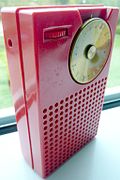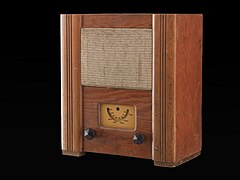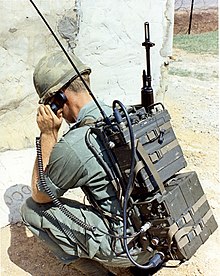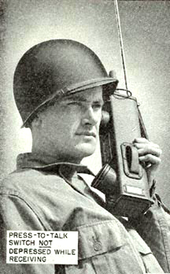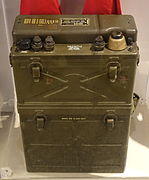In radio communication, a transceiver is an electronic device which is a combination of a radio transmitter and a receiver, hence the name. It can both transmit and receive radio waves using an antenna, for communication purposes. These two related functions are often combined in a single device to reduce manufacturing costs. The term is also used for other devices which can both transmit and receive through a communications channel, such as optical transceivers which transmit and receive light in optical fiber systems, and bus transceivers which transmit and receive digital data in computer data buses.

In electronics and telecommunications, a radio transmitter or just transmitter is an electronic device which produces radio waves with an antenna. The transmitter itself generates a radio frequency alternating current, which is applied to the antenna. When excited by this alternating current, the antenna radiates radio waves.
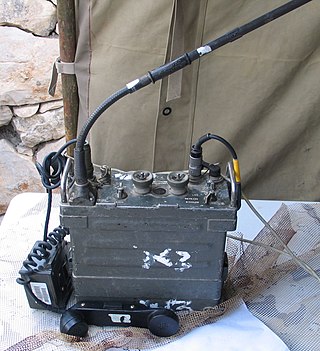
AN/PRC 77 Radio Set is a manpack, portable VHF FM combat-net radio transceiver manufactured by Associated Industries and used to provide short-range, two-way radiotelephone voice communication. In the Joint Electronics Type Designation System (JETDS), AN/PRC translates to "Army/Navy, Portable, Radio, Communication."

A walkie-talkie, more formally known as a handheld transceiver (HT), is a hand-held, portable, two-way radio transceiver. Its development during the Second World War has been variously credited to Donald Hings, radio engineer Alfred J. Gross, Henryk Magnuski and engineering teams at Motorola. First used for infantry, similar designs were created for field artillery and tank units, and after the war, walkie-talkies spread to public safety and eventually commercial and jobsite work.

Marine VHF radio is a worldwide system of two way radio transceivers on ships and watercraft used for bidirectional voice communication from ship-to-ship, ship-to-shore, and in certain circumstances ship-to-aircraft. It uses FM channels in the very high frequency (VHF) radio band in the frequency range between 156 and 174 MHz, inclusive, designated by the International Telecommunication Union as the VHF maritime mobile band. In some countries additional channels are used, such as the L and F channels for leisure and fishing vessels in the Nordic countries. Transmitter power is limited to 25 watts, giving them a range of about 100 kilometres.

Henryk Władysław Magnuski was a Polish telecommunications engineer who worked for Motorola in Chicago. He was a primary contributor in the development of one of the first Walkie-Talkie radios, the Motorola SCR-300, and influenced the company's success in the field of radio communication.

A two-way radio is a radio transceiver, which is used for bidirectional person-to-person voice communication with other users with similar radios, in contrast to a broadcast receiver, which only receives transmissions.
The 33-centimeter or 900 MHz band is a portion of the UHF radio spectrum internationally allocated to amateur radio on a secondary basis. It ranges from 902 to 928 MHz and is unique to ITU Region 2. It is primarily used for very local communications as opposed to bands lower in frequency. However, very high antennas with high gain have shown 33 centimeters can provide good long-range communications almost equal to systems on lower frequencies such as the 70 centimeter band. The band is also used by industrial, scientific, and medical (ISM) equipment, as well as low-powered unlicensed devices. Amateur stations must accept harmful interference caused by ISM users but may receive protection from unlicensed devices.

Mobile radio telephone systems were mobile telephony systems that preceded modern cellular network technology. Since they were the predecessors of the first generation of cellular telephones, these systems are sometimes retroactively referred to as pre-cellular systems. Technologies used in pre-cellular systems included the Push to Talk, Mobile Telephone Service (MTS), Improved Mobile Telephone Service (IMTS), and Advanced Mobile Telephone System (AMTS) systems. These early mobile telephone systems can be distinguished from earlier closed radiotelephone systems in that they were available as a commercial service that was part of the public switched telephone network, with their own telephone numbers, rather than part of a closed network such as a police radio or taxi dispatching system.
MOTO Talk is a feature on some Motorola iDEN cellular phone handsets which allows users to make short-range 'push-to-talk' calls to other such handsets without being on the iDEN network. This feature goes by different names on iDEN service providers. In the US, Nextel called it 'DirectTalk' and included it as a free service on most new models of Motorola handsets. Boost Mobile disabled the function via handset software settings. SouthernLINC calls it LINCaround and ships handsets with the feature disabled. It can be enabled after paying an activation fee of $20. In Canada, TELUS calls it "Mike's Talk-Around."

Larkspur was the retrospectively adopted name of a tactical radio system used by the British Army. Its development started in the late 1940s with the first equipment being issued in the mid-1950s. It remained in service until replaced by Clansman in the late-1970s although some elements of Larkspur were still in service well into the 1980s. It was widely exported to British Commonwealth armies and other friendly nations.

Mobile radio or mobiles refer to wireless communications systems and devices which are based on radio frequencies, and where the path of communications is movable on either end. There are a variety of views about what constitutes mobile equipment. For US licensing purposes, mobiles may include hand-carried,, equipment. An obsolete term is radiophone.

The SCR-536 was a hand-held radio transceiver used by the US Army Signal Corps in World War II. It is popularly referred to as a walkie talkie, although it was originally designated a "handie talkie".
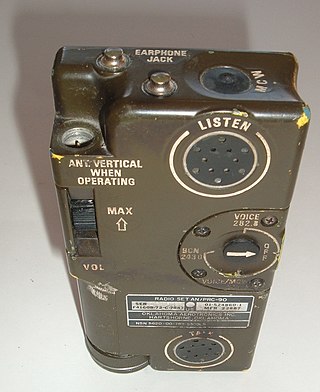
Survival radios are carried by pilots and search and rescue teams to facilitate rescue in an emergency. They are generally designed to transmit on international distress frequencies. Maritime systems have been standardized under the Global Maritime Distress Safety System. Civil and military organisation's utilized different frequencies to communicate and no infringement on either sector would take place. For emergencies involving civilian aircraft, the radio frequency used is VHF 121.5 MHz and for military aircraft incidents, the frequency used is UHF 243 MHz.
The AN/PRC-6 is a walkie-talkie used by the U.S. military in the late Korean War era through the Vietnam War. Raytheon developed the RT-196/PRC-6 following World War II as a replacement for the SCR-536 "handy-talkie". The AN/PRC-6 operates using wide-band FM on a single crystal controlled frequency in the 47 to 55.4 MHz low band VHF band.

The SCR-300 was a portable radio transceiver used by US Signal Corps in World War II. This backpack-mounted unit was the first radio to be nicknamed a "walkie talkie".
During World War II, the German Army relied on an diverse array of communications to maintain contact with its mobile forces and in particular with its armoured forces. Most of this equipment received the generic prefix FuG for Funkgerät, meaning "radio device". Occasionally the shorted Fu designation were used and there were exceptions to both these systems. Number ranges were not unique across the services so sometimes different equipment used by different services had the same FuG prefix. This article is a list and a description of the radio equipment.
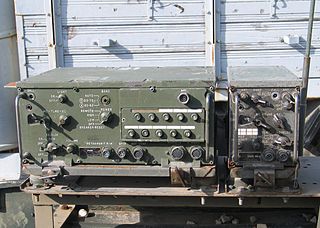
The AN/VRC-12 is the lowest-numbered element of a family of vehicular VHF-FM synthesized vehicular radio communications systems developed by Avco Corporation and introduced around 1963 and used extensively by the U.S. military during the Vietnam War and for many years after. It replaced the earlier AN/GRC-3 through 8 series and was, in turn, replaced by the Single Channel Ground and Airborne Radio System (SINCGARS) in the early 1990s. The sets were manufactured by its original developer, Avco based in Cincinnati, Oh, and Magnavox, Ft. Wayne, Indiana Texas Instruments was one of the principal bidders that proposed improved, ultra-reliable (failure-free) variant of VRC-12 in the late 1960s, but failed to win the competition. RCA bid for ultra-reliable variant in the early 1970s was also unsuccessful.
The AN/PRC-10 is an American VHF portable radio transceiver, introduced in 1951 as a replacement for the wartime SCR-300 set. The AN/PRC-8 and AN/PRC-9 sets are basically the same but cover lower frequency bands. It remained in service with the American military until the mid 1960s when it was replaced by the transistorized AN/PRC-25 set.








